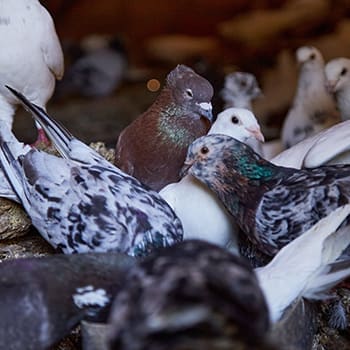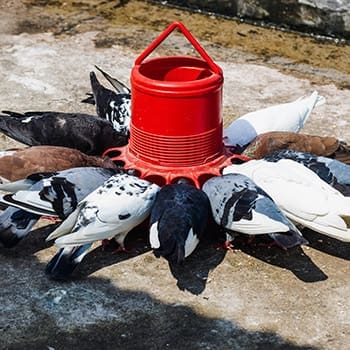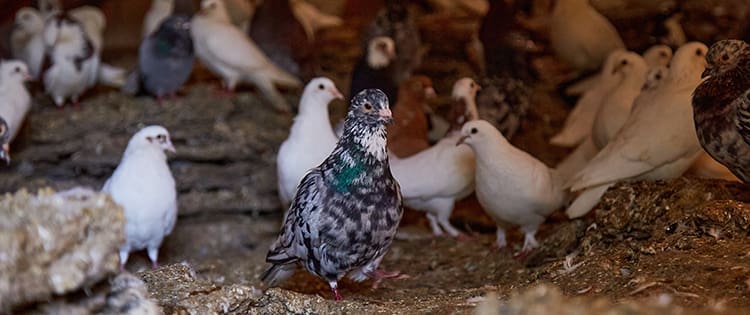When it comes to raising fowl on your homestead, one type that is often overlooked is pigeons. They are a great way to raise your own meat with very little work on your part and with very little startup money. Pigeons have small space requirements with no need for incubators and space heaters to keep their young warm. Pigeons are often permitted in more urban areas where raising chickens or ducks aren’t legally allowed.
Why Pigeons Instead Of Chickens Or Ducks?
If you’re just looking for good egg-laying fowl, it’s best to stick with chickens and ducks. It’s also true that chickens and ducks have a lot more meat on their body for eating. However, pigeons can be raised for a fraction of the cost and a lot less work. They are often allowed in areas where chickens and ducks are not.
How To House Your Pigeons?

The first thing to consider is the location of your lofts (pigeon houses). Make sure that wherever you put them, that they get a lot of sun. Southern exposure is best. It is important to keep the housing area dry to keep them in the best health.
For twelve pairs of pigeons, you should have an area of about 6’ x 8’ for 48 square feet of floor space. Many people surround their pigeon coops with wire fencing to keep them free of rodents. Depending on your climate, you can choose an open or semi-closed front. In colder climates, warmers for the floor or nesting bowls might be necessary.
Pigeons lay eggs in a bowl type of container. The ideal laying bowl would be sturdy enough for them to perch on the edge without it falling over. Some pigeon enthusiasts use a paper bowl that can be discarded for sanitary purposes. Nests should be 12” across and 15” high.
Many pigeon breeders make sure that there are two nesting bowls per pair of pigeons because will often start laying another set of eggs while looking after a set of squabs. If you don’t provide nesting bowls, you should provide longleaf pine needles, straw, hay, and tobacco stem to allow them to build their own nests. Nests and nest bowls should be cleaned out when squabs are harvested in preparation for another round of laying.
Sand or gravel that’s a few inches deep make an ideal floor because it’s easy to clean.
What Are Some Good Meat Breeds?
There are a number of breeds of pigeons. Some people raise them for show or flying. However, anyone that’s homesteading will likely be interested in their meat.
The two breeds that are the most common and best pigeons for meat are the King and Carneau. The White King matures quickly, is hardy, and the white feathers that make it easier to dress. Some people favor the Texan Pioneer because they are easy to sex with due to the males and females having different colored feathers. Some other breeds that are highly spoken of are Homer, Runt, and Mondaine.
You can see if there is a local seller where you can buy mated pairs. If not, you can get them through the mail. It’s ideal that they’re about 6-8 weeks old when you purchase them.
What To Feed Your Pigeons?

One of the things that make raising pigeons easy is that you don’t have to worry too much about feeding baby pigeons. From a young age, the parents feed the squabs a regurgitated food with a milky secretion that they possess. In fact, some people don’t even feed their pigeons and allow them to roam freely and find their own food.
Pigeons need grit as other poultry birds do. Red pigeon grit is the best choice. If it’s not available, then you can use regular poultry or game bird grit.
There are several feed options depending on how involved you want to be in the care of your pigeons. You can let them fend for themselves for food. This is the cheapest and easiest option. However, this will result in laying less often depending on their food supply.
It is often difficult and pricey to find feed specifically formulated towards pigeons. You can feed them a pelleted poultry feed which has everything that they need including necessary minerals. There is also the option of an all-grain poultry feed. If you feed them this option, you will definitely need to provide grit for them as well.
For water, you can use a regular chicken fountain. You can also use a sturdy dish attached to the wall of their housing. It’s important to change the water daily. A feed hopper might be a good idea to keep food waste to a minimum but only keep about one day’s worth of food in there.
What Are Some Other Tips For Raising Pigeons For Food?
Ideally, pigeons should be de-wormed twice a year against parasites. Adding half an ounce of 8% bleach to each gallon of water will do a lot to keep your birds from getting sick. It also helps to keep the water from getting green and gross.
There are some small differences between males and females. Males usually have slightly larger heads with thicker necks. They tend to puff up their chest and are more vocal to attract a mate. However, the real best way to figure out which pigeons are male and female is to just wait until they have chosen a partner to mate with.
One pair of breeder pigeons will usually produce 12-14 squabs a year. Twelve pairs are a typical amount and will provide your family with about 144 squabs a year. Pigeons sit on their eggs for 17-18 days until they hatch.
It’s a good idea to move squabs out of the nest when they’re eating on their own. Other adults can be mean to them and even cause their deaths. If you do have a separate space set up for squabs, make sure their food and water are set close to the ground. It’s also a good idea to splash a little of the water on their beaks, just to be sure they know where it is.
Squabs grow rapidly and are usually ready to eat when they’re fully feathered under the wings. This happens when they’re about 26 days old. A well-dressed squab will usually be several ounces. It’s usually just the breast meat that is eaten. Each squab is considered a single serving of dark meat. Pigeons are considered full-grown and will start to mate at six months.
To process them, hang them from their feet by a hook or a nail and cut the jugular vein in their neck. To lock the wings to keep them from flapping, twist them behind one another. You’ll have to pick the feathers out immediately because it becomes difficult if you wait too long. After they’ve been picked, you can cool them for 1-3 hours in ice water, but no longer than that.
Final Thought
There really isn’t a great market for pigeons. While you can sell them, it’s difficult to find regular buyers. However, some restaurants might be willing to buy them regularly.
Pigeons make a great alternative fowl to raise for homesteaders, whether it’s instead of or in addition to chickens and/or ducks.
You may also like:
Build Your Chicken Coop With $50 In One Hour
An Ingenious Eggshell Remedy and 25 Others Made from Things People Usually Throw Away (Video)
Livestock Animals You Should Start Raising For The Upcoming Economic Crisis









